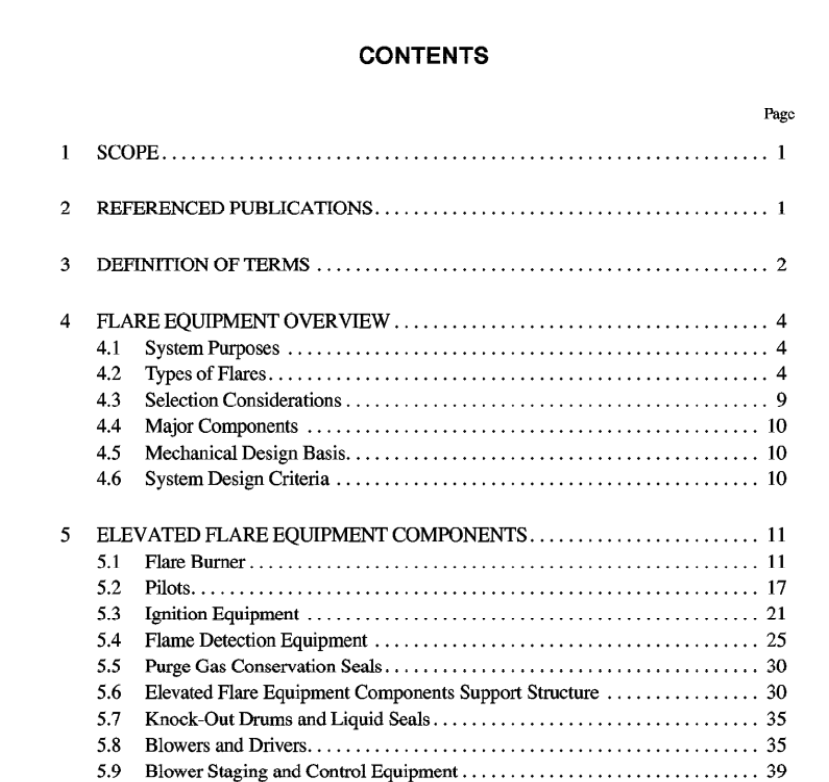API Std 537 pdf download

API Std 537 pdf download.Flare Details for General Refinery and Petrochemical Service
3 Definition ofTerms
Terms used in this Standard as they relate to flares are defined in 3.1 through 3.68. 3.1 air seal: A device used to minimize or eliminate the intrusion of air back into the riser from the exit. 3.2 assist gas: Fucl gas that is added to relief gas prior to the flare burner or at the point of combustion in order to raise the heating value. 3.3 back blowing: The procedure by which the dry air seal drain line is blown back from the base of the drain into the buoyancy seal to ensure the line is clear. 3.4 blowoff: The loss of a stable flame where the flame is lifted above the burner. This occurs if the fuel velocity exceeds the flame velocity. 3.5 buoyancy seal: A dry vapor seal that minimizes the required purge gas needed to protect from air infiltration. It functions by trapping a volume of light gas in an internal inverted compartment. This prevents air from displacing buoyant light gas in the flare. 3.6 burnback: Intermal burning within the tip. This might result from air backing down the flare burmer at purge or low flaring rates. 3.7 burn-pit flare: An open excavation nomally equipped with a horizontal fare bumer that can handle liquid as well as vapor hydrocarbons. 3.8 burning velocity: The speed at which a flame front travels into an unburned combustible mixture. 3.9 coanda flare: A flare bumer that is designed to employ the acrodynamic effect where moving fluids follow a curved or inclined surface over which they flow. Flares of this type generally use steam or pressure to achieve smokeless performance. 3.10 combustion air: Air required to combust the flare gases. 3.11 combustion efficiency: The percentage of the combustible fuid totally oxidized in the burner. In the case of hydrocarbons, combustion efficiency is the weight percent of carbon in the original fuid that oxidizes completely to CO2. 3.12 condensable gas: A vapor that can condense at the temperature and pressure expected in a flare header during or after a flaring event. 3.13 derrick support: A support system for the elevated flare riser normally used for very tall flares or when plot space is limited. Various derrick supported arrangements are avail- able: a fixed system has its riser permanently supported to the derrick; a dcmountablc derrick has multiplc riscr scctions that are designed to be lowered and removed to permit lowering of the flare burmer to grade; a demountable derrick with one fixed riser provides for a single piece design to be lowered to grade as a single component. 3.14 design flare capacity: The maximum design flow to the flare normally expressed in kilograms per hour (pounds per hour) of a specific composition, temperature, and pres- sure. 3.15 destruction efficiency: The weight percent of the fluid vapor that can be oxidized that is at least partially oxi- dized. In the case of a hydrocarbon, destruction efficiency is the weight percent of carbon in the fluid vapor that oxidizes to CO or CO2. 3.16 detached stable flame: A flame which is not in contact with the fiare burmer itself but burns with a stable flamefront in the vicinity of the flare bumer.
4 Flare Equipment Overview
4.1 SYSTEM PURPOSES A flaring system is provided in a refinery or petrochemical plant to ensure the safe and efficient disposal of relieved gases or liquids. The disposal fAuids are collected in a flare header and routed to the fare. It is extremely important in the event of a plant emergency such as a fire or power failure. A prop- erly operating flare system is the critical component to pre- vent a plant disruption from turming into a disaster. A flare is expected to operate twenty-four hours a day. Flare must be in service for several years without a need to shut it down. It always be available for flaring whenever a plant disruption occurs. Proper design, operation and maintenance of emergency flaring systems are extremely important. These can ensure the safety of personnel, facility, and the surrounding community. The intention and operational limitations of the Flare System should be documented clearly and all operational staff made aware of this documentation. The flaring system must be designed to do the following: ●Reduce ground level concentrations of hazardous materials. ●Provide the safe disposal of flammable materials. ●Reduce volatile organic compound (VOC) and hydro- carbon emissions.









